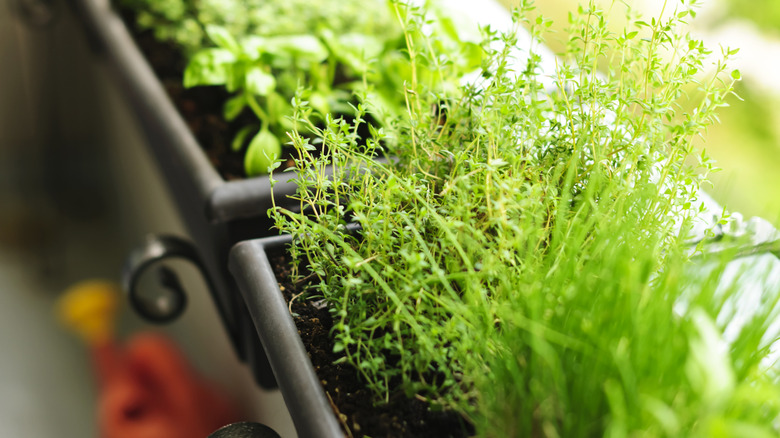Why Window Boxes Outshine Regular Plant Pots For Balcony Gardens
Arguably, one of the most important things to consider before starting a balcony garden is what you're going to grow the plants in. The natural containers that spring to mind are plant pots — from the cheap and practical round, plastic tubs with holes in the bottom to highly decorative plaster, concrete, or terracotta planters. There just might be, however, a better alternative. Window boxes are often overlooked as balcony garden containers because, as their name implies, they're designed to sit outside a window. Don't be so easily fooled. The much larger size of these nifty planters offers you the chance to create a permanent balcony garden that can house miniature ecosystems. Also, they retain soil, water, and nutrients better, plants can really dig their roots into the abundant potting medium, and the containers' height and mountability make for a back-friendly gardening experience.
Like the humble plant pot, window boxes have been around for literal ages. Written evidence suggests they were popular even in ancient Rome. The boxes are typically made of lightweight plastic or wood. Also popular are hayrack window boxes; these are wire baskets fitted with sphagnum moss or coir liners. When used in a balcony setting, they're typically mounted to the balcony railings — like these beautiful DIY railing planters — or the frame of any window facing out onto the balcony. There is, of course, nothing keeping you from placing a window box on the floor of your balcony. Sit a few bricks underneath it to raise it up off the floor a little, protecting your balcony and improving drainage for the plants growing inside.
The benefits of window boxes explained
You can effectively treat window boxes like compact raised beds. They're generally a lot larger — far wider and (usually) deeper — than pots. So, a 40-or-so-inch-long window box fits somewhere between five and ten plants compared with the one, maybe two, you can squeeze into a medium-sized pot. Also, the dimensions of a window box allow each plant to spread out both under and above the soil and get more light. Square containers hold 50% more soil compared to similarly sized round pots. Deeper pots also retain water better; you won't have to water the plants they house as often. There might even be room for mulch!
Thanks to their size, window boxes give you the chance to create an abundant miniature garden for hummingbirds or a butterfly habitat filled with pollen-heavy blooms and leaves for hungry caterpillars. Traditionally, window boxes are planted with short-lived flowering annuals, but contemporary experts often mix in perennials to create cleverly planned ecosystems. A large box is much better for building a mini ecosystem than lots of disparate, disconnected pots. Suffer from a bad back? You can mount window boxes to your balcony railings, a stand, or a sill at a back-friendly height for a less painful gardening experience.
Despite what it may seem, window boxes are not, of course, entirely without fault. A thorough watering renders the soil — and, thus, the entire garden — heavy, potentially exceeding balcony design loads. The increased weight and size of a window box also makes it more cumbersome to move around than individual pots. In other words, consider them a more permanent fixture.

